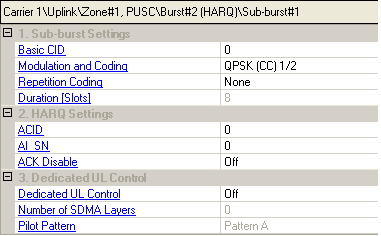

Each sub-burst size is indicated by the property and slots are allocated in frequency-first order from the end of last sub-burst. For the last sub-burst, if assigned slots are larger than occupied slots, 0xff will be padded to make the data block fit the assigned slots size.
At least one MAC PDU is defined in the HARQ sub-burst, otherwise, an error will be displayed on status bar. You can add, delete, copy or change the order of MAC PDUs. To generate a sub-burst, ccitt-16 bit CRC is appended to the concatenated MAC PDUs after padding and then channel coding is applied to the data block.
Range: 0 to 65535
Enter the Basic Connection ID that indicates a specific subscriber station where the HARQ DL MAP IE are described for.
Select the modulation type, coding type, and coding rate from the drop down menu. The type of coding available depends on the burst profile.
RAW – data is mapped to the OFDMA user carriers without any randomizing, encoding, or interleaving.
CC – data is randomized, encoded using convolutional coding, and interleaved according to the standard specifications.
CTC – data is randomized, encoded using convolutional turbo coding, and interleaved according to the standard specifications.
Choices: None, 2, 4, 6
Select the number of times the coded or uncoded data is repeated.
Repetition Coding number of 2, 4, or 6 can only be applied when the Modulation type is QPSK. Otherwise, an error message displays in the status bar.
Displays how many slots are needed for the HARQ sub-burst based on the total length of sub-burst after CRC calculation. The value of this parameter should be the least number of slots that can accommodate "Sub-burst length” + 16 bits ”r;CRC” data. Padding bits is appended before CRC when the allocation is larger than needed.
The process of retransmissions is controlled by the BS using the ACID (ARQ Channel ID) and AI_SN fields in the DL and UL maps. Each HARQ channel (indicated by specific ACID of 0–15) is managed separately.
When the AI_SN field in the HARQ channel remains the same between two HARQ burst allocations, it indicates retransmission. In this case, the transmitter is required to retransmit the same data that was transmitted using the same ACID and AI_SN. The burst profile of the retransmission must be the same as in the first transmission; however, the level of boosting and repetition may be changed.
When the AI_SN field in the HARQ channel is changed, it indicates transmission of new data. In this case, the data stored in the transmitter and receiver for this ACID and the previously used AI_SN may be discarded.
Range: 0 to 15
Enter the ARQ Channel ID that indicates a specific HARQ transmission between a base station and subscriber station. This is used in the HARQ MAP IE.
Range: 0 to 1
Enter the AI_SN (ARQ Identifier Sequence Number) value of a specific HARQ transmission. When the AI_SN field in the HARQ channel remains the same between two HARQ burst allocations, the sub-burst is retransmitted. This is used in the HARQ MAP IE.
Choices: On, Off
Select the ACK Disable status that indicates whether the allocated sub-burst requires an ACK to be transmitted by subscriber station. This is used in the HARQ MAP IE. This parameter determines the number of ACK channels.
Choices: On, Off
Select the state of Dedicated DL Control that indicates whether the Dedicated DL control information will be included in HARQ DL MAP IE.
Range: 0 to 3
Enter the total number of SDMA (spatial division multiple access) layers associated with HARQ MAP IE when Dedicated DL Control is set to On.
Choices: Pattern A, Pattern B, Pattern C, Pattern D
Select the pilot pattern for SDMA control information.